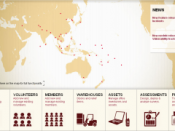Author: Nuwan Waidyanatha
-
Teach Myanmar CAP and They will have CAP for Life
The Department of Meteorology and Hydrology (DMH) has championed in implementing and operationalizing their warning and situational-awareness platform, hosted at www.dmhwarnings.gov.mm Workshop Intro To discuss the next steps and bring closure to the CAP on a Map project, a dissemination workshop was held in Naypyitaw (02 September 2016). The workshop was held at the Hotel…
-
Alert Hubs, a Topic at the 2016 CAP Forum Among Experts
Alert Hubs will play a significant role in receiving and sharing early warnings. It was anticipated that each Nation would require to host a National Alert Hub. Those Alert Hubs would feed into the Global Filtered Alert Hubs. Eliot Christian in his presentation said, “With so many countries implementing CAP-enabled alerting, we can see that…
-
SAMBRO Warning Exercise in the Maldives
SAMBRO Centralizes Emergency Information Management but Decentralizes the Emergency Management Responsibilities To prove the concept, we carried out early warning controlled-exercises in the Island of Tulesdoo, in the Maldives. It’s located 27KM DIRECTION of the capitol city Male. Similar to other Islands, the Island Council members are also responsible for emergency and crisis response. The…
-
SAMBRO Tested and Myanmar is Ready to Go Live
The Myanmar Department of Meteorology and Hydrology (DMH) is now publishing live CAP feeds through their Warning and Situational-Awareness platform. Prior to making the decision to publish live alerts, through the CAP-enabled Sahana Alerting and Messaging Broker (SAMBRO), DMH and associated Stakeholders conducted a series of silent-tests and live-exercises. The silent-tests, carried out over three…
-
PAGASA Originating and SAMBRO Relaying CAP Warning Messages in the Philippines
Originate and Relay Alerts Philippines Atmospheric Geophysical and Astrological Service Administration (PAGASA) and the Sahana Alerting and Messaging Broker (SAMBRO) systems’ interoperability was tested during the controlled-exercise in Manila, Philippines (11-14th July 2016). The process was simple – valid Common Alerting Protocol (CAP) messages originating from the PAGASA “public alerting” software tool were received into…
-
None Forgotten with Sahana Situational-Awareness – Maldives!
A Ministry of Tourism (MOT), Health Protection Agency (HPA), and the Maldives Red Crescent Society (MRCS) concern was: why the Maldives National Defence Force (MNDF) and the National Disaster Management Center (NDMC) did not notify other organizations during crises? Fare enough, MNDF and NDMC primary objective is assessing the situation, dispatching response resources, and mitigating the…
-
Myanmar Loving the SAMBRO Mobile APP
We conducted controlled-exercises in the Nyaungdon and Kunyangong Townships in Myanmar. The SAMBRO mobile app was exciting to the participating emergency firs-responders. The number of participants grew from 10 to 25 when they heard of the mobile app and were keen in testing the application. A significant number of the first-responders; especially in Kunyangong, did…
-
Geocodes important to Philippines in their Early Warning
The Common Alerting Protocol (CAP) requires that the targeted alert area is defined. The CAP areaDesc (i.e. the area Description) is a mandatory element. Whereas the polygon element in CAP is optional. However, the use of polygons are becoming quite popular, especially with web-based rendering that uses maps to display the alerting area. The Sahana…
-

Sahana Resource Management System for Telecom Operators
Nepal Earthquake did not affect their telecommunications relative to the damages and losses in other sectors. Nevertheless, they faced the challenge of managing the crisis; especially, with restoring communication services.The lessons were discussed at INET Kathmandu. I came to learn that telcos run their own Emergency Operations Center (EOC) and they need to manage who…
-
Myanmar trained their SAMBRO Users
Myanmar SAMBRO Users pose with their situational-awareness map in the backdrop. After two days of training (25 & 26 Feb, 2016), they now have a better understanding as to how the system will improve their alerting efficiency and institutional responsiveness to local and national scale hazard events. The Key Myanmar Users received training, from the…
